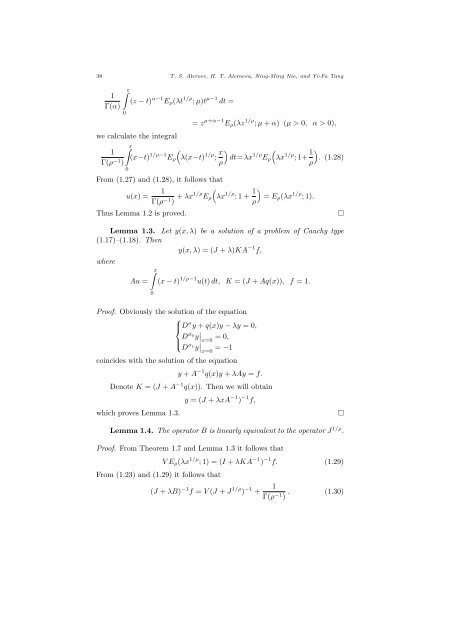FOR DIFFERENTIAL EQUATIONS OF FRACTIONAL ORDER
FOR DIFFERENTIAL EQUATIONS OF FRACTIONAL ORDER
FOR DIFFERENTIAL EQUATIONS OF FRACTIONAL ORDER
Create successful ePaper yourself
Turn your PDF publications into a flip-book with our unique Google optimized e-Paper software.
38 T. S. Aleroev, H. T. Aleroeva, Ning-Ming Nie, and Yi-Fa Tang1Γ(α)∫ z0(z − t) α−1 E ρ (λt 1/ρ ; µ)t µ−1 dt =we calculate the integral1Γ(ρ −1 )∫ x0= z µ+α−1 E ρ (λz 1/ρ ; µ + α) (µ > 0, α > 0),((x−t) 1/ρ−1 E ρ λ(x−t) 1/ρ ; x ) (dt=λx 1/ρ E ρ λx 1/ρ ; 1+ 1 ). (1.28)ρρFrom (1.27) and (1.28), it follows that1u(x) =Γ(ρ −1 ) + λx1/ρ E ρ(λx 1/ρ ; 1 + 1 )ρThus Lemma 1.2 is proved.= E ρ (λx 1/ρ ; 1).Lemma 1.3. Let y(x, λ) be a solution of a problem of Cauchy type(1.17)–(1.18). Theny(x, λ) = (J + λ)KA −1 f,whereAu =∫ x0(x − t) 1/ρ−1 u(t) dt, K = (J + Aq(x)), f = 1.□Proof. Obviously the solution of the equation⎧⎪⎨ D σ y + q(x)y − λy = 0,D⎪⎩σ0 y ∣ x=0= 0,D σ 1y ∣ x=0= −1coincides with the solution of the equationy + A −1 q(x)y + λAy = f.Denote K = (J + A −1 q(x)). Then we will obtainy = (J + λxA −1 ) −1 f,which proves Lemma 1.3.□Lemma 1.4. The operator B is linearly equivalent to the operator J 1/ρ .Proof. From Theorem 1.7 and Lemma 1.3 it follows thatFrom (1.23) and (1.29) it follows thatV E ρ (λx 1/ρ ; 1) = (I + λKA −1 ) −1 f. (1.29)(J + λB) −1 f = V (J + J 1/ρ ) −1 +1Γ(ρ −1 ) . (1.30)
















